 |
All About Garlic - Cooking Tips | |||||||||||||||||||||||||||||||||||||||||||||||||||||||||||||||||||||||||||||||||||||||||||||||||
| view article online: https://www.recipetips.com/kitchen-tips/t--1263/all-about-garlic.asp | |||||||||||||||||||||||||||||||||||||||||||||||||||||||||||||||||||||||||||||||||||||||||||||||||
| |||||||||||||||||||||||||||||||||||||||||||||||||||||||||||||||||||||||||||||||||||||||||||||||||
|
Breaking the bulb: Begin by removing the outer layer of the garlic. With stem pointed into work surface and bulb at a slight angle, press down and away with the heal of your hand. |
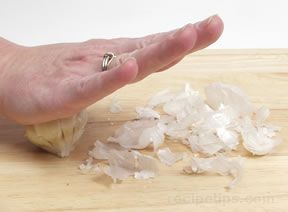 |
| The bulb will break into individual "cloves". | 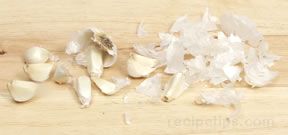 |
| Peeling the clove: After the cloves have been separated, trim off the root end. | 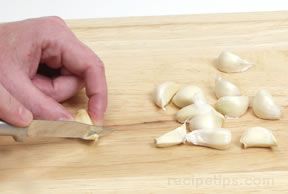 |
|
Twist the clove between your fingers to loosen the skin. Once the skin has loosened, remove. If the garlic is fresh, loosening the skin tends to be more difficult. |
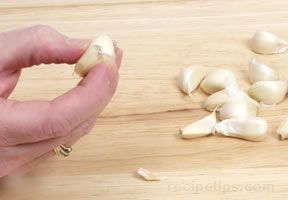 |
The clove can now be cooked whole, or it can be sliced, chopped, minced, or smashed. The intensity of flavor of fresh garlic depends upon how the garlic is prepared. See below for how the different preparation methods for garlic affect its flavor.
|
Whole Cloves - Mild Flavor The juices and oils of whole garlic have not been extracted, which results in a mild flavor. |
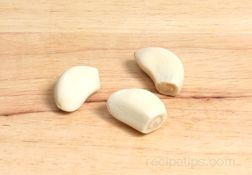 |
|
Sliced Cloves - Mild Flavor Larger pieces, such as slices, will not totally dissolve when cooked, which will result in a milder flavor than chopped, minced, or smashed garlic. To slice, place the peeled clove on its side and make thin crosswise cuts. |
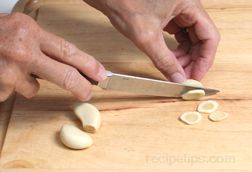 |
| When it gets so it is hard to hold on to the clove, turn it so the flat cut side is down on the cutting board. Finish cutting in thin slices. | 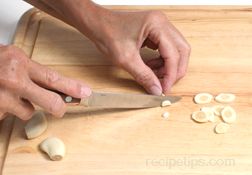 |
|
Chopped Cloves - Medium Flavor Chopping the garlic into smaller pieces will allow a little more of the juices and oils to be released. This will provide more flavor than slicing and the amount of flavor will depend on the size of the pieces. The smaller they are the more flavor will be released. | |
| To chop the cloves, first make several lengthwise sliced through the clove but do not cut all the way through the root end. The number of slices you make will depend on the size of the clove and how big you want the chopped pieces to be. | 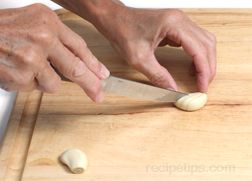 |
| After making the lengthwise slices, turn the clove and cut the clove crosswise to create the chopped pieces. Cut to desired thickness. |  |
|
Minced Cloves - Full Flavor Mincing the garlic cloves releases a large amount of juices and oils to provide a strong flavor to the other ingredients of the dish the garlic is cooked with. Begin by slicing lengthwise as you would when chopping the cloves, only cut in to thinner slices. |
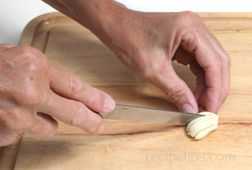 |
| Turn the clove and cut crosswise in thin slices to create small pieces. | 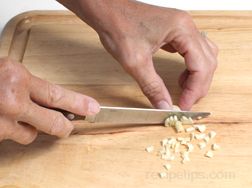 |
| After the pieces are cut, scrape them into a pile and begin cutting the pieces into smaller pieces with a chef's knife. Place the palm of one hand on the top of the blade and with a rocking motion, move across the pile of garlic, cutting them as you go. Several passes will have to be made to cut them into fine enough pieces. Scrape the garlic back into a pile as needed. | 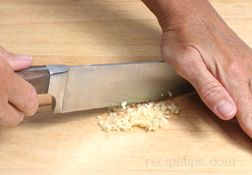 |
|
Smashed Cloves - Intense Flavor When the cloves have been smashed they provide a very intense flavor because much of its juices and oils are released. The only methods that will produce more flavor is pressing or pureeing the garlic. Mince the garlic as shown above and then sprinkle very lightly with salt. |
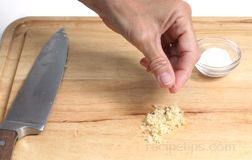 |
| Place the flat side of the chef's knife on top of the minced garlic with the cutting edge away from you. Using your other hand, apply pressure by placing your fingers on the blade and pull it towards you. Then push it back up in a slight circular motion. | 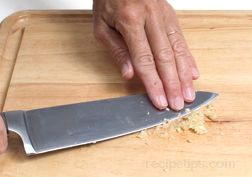 |
| Continue this motion repeatedly over the garlic until it is all smashed. The garlic will be slightly liquefied. | 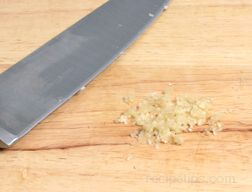 |
Garlic Cooking
Caution must be taken when cooking garlic so that it is not overcooked. Garlic burns easily and when it has been cooked too long or on too high of a temperature, it will turn bitter. Some of the common cooking methods are shown below.
Sautéing Garlic
Sautéing is the most common method used for cooking garlic. It will bring out the nutty but savory flavor of the garlic. Garlic can be sautéed in oil or butter but be careful is using butter because is will burn much faster than oil.
- Select a pan or skillet with a heavy bottom that will provide for even heating.
- Heat the oil or butter over medium heat and then add the garlic.
- The garlic should be stirred often to prevent burning.
- If cooking with other ingredients that take longer to cook, such as onions, start cooking the other ingredients and allow them to start to cook before adding the garlic.
Oven Roasting Garlic
|
Roasting Whole Bulbs
Remove the skin from the garlic bulb and cut off approximately 1/4 inch of the tips of the garlic. |
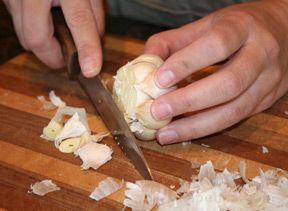 |
|
Place the bulb on a piece of aluminum foil large enough to wrap the garlic. Then drizzle it with vegetable oil, canola oil, or olive oil. |
 |
| Wrap the bulb tightly in the aluminum foil and place in the preheated oven. | 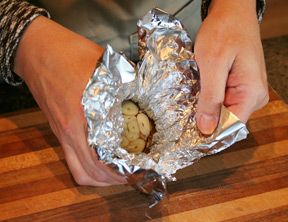 |
| Roast the garlic bulb for approximately two hours or until the cloves are tender when poked with a fork. | 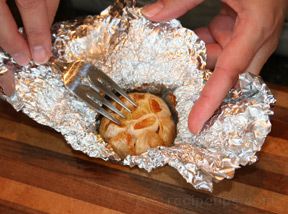 |
|
Roasting Individual Cloves
| |
Frying Garlic
- Use a heavy bottomed deep pan, such as a saucepan and add oil.
- Heat oil on the stove until it is very hot but not smoking and then add garlic cloves.
- Fry cloves only until they turn a medium brown and the remove from the heat.
- Watch very carefully as they begin to brown to avoid burning them. Burnt garlic will have a bitter taste.
Tips
- Place garlic cloves in the microwave for 15 seconds and the skins should peel off easily.
- Keep peeled and mince garlic fresh by placing it in a small jar and pouring just enough olive oil over it to cover the garlic and then place it in the refrigerator. It will keep its fresh flavor for about a week.
- Add garlic flavor to your salad by cutting a raw garlic clove in half and rubbing the inside of your bowl with the cut edge of the clove.
- Don't throw out sprouting garlic. Instead, plant the cloves fairly close together in a pot or in the garden (if your climate is suitable at the time). The new shoots that appear will have a mild garlic flavor and can be used in the same manner as regular chives.
- To remove the garlic odor from your hands when working with garlic, wash hands thoroughly and then use some type of stainless steel device that can be worked over and around the areas affected on fingers or hands. Stainless steel contains the mineral nickel which acts as a neutralizer for the garlic odor. Several manufacturers provide a kitchen utensil, similar to a flat bar of soap made of stainless steel, that can be rubbed over the hands after coming in contact with garlic. Other options include using a faucet or stainless steel sink surface to rub hands on after first washing the exposed areas.






